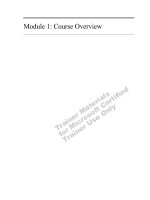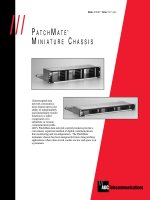Tài liệu About This Course pptx
Bạn đang xem bản rút gọn của tài liệu. Xem và tải ngay bản đầy đủ của tài liệu tại đây (131.63 KB, 8 trang )
About This Course
Course Overview
This section provides you with a brief description of the course, audience,
suggested prerequisites, and course objectives.
Description
This workshop is a part of the Microsoft
®
Business Solutions Design
Curriculum, a series of four Microsoft Official Curriculum (MOC) courses. The
workshop teaches students how to design business solutions by using models of
the Microsoft Solutions Framework (MSF). Students will learn about the MSF
Process Model for Application Development and the MSF Application Model.
Throughout the course, students will use the models to guide them in the
process of business solutions design.
Students will learn how to progress through the phases of the MSF Design
Process to create a design that solves a business challenge. They will learn how
to segment a solution into layers and the benefits of doing so. Finally, they will
learn about creating a functional specification that contains the information
necessary for beginning the development of the solution.
Audience
The intended audience for this course includes software developers who have at
least six months of experience and who are looking to become consultants,
project managers, business analysts, program managers, and architects working
with Microsoft products and technologies in a business environment.
This course is also for software developers and other application development
professionals who want to know more about how to design business or
enterprise solutions that meet customer requirements. The course delves into
application design issues and considerations for selecting specific
implementation technologies. It does not, however, teach implementation or
development skills.
Student Prerequisites
This course requires that students meet the following prerequisites:
!
Six months of experience as part of a software development team
!
General understanding of a software development life cycle
!
General knowledge of Microsoft technologies
!
General understanding of the process of gathering and analyzing business
requirements
xiv About This Course
xiv About This Course
Recommended Courses
!
Course 1585: Gathering and Analyzing Business Requirements or
equivalent experience and knowledge
Course Objectives
At the end of this course, the student will be able to:
!
Use the MSF Process Model and MSF Application Model to develop
conceptual, logical, and physical designs of a business solution.
!
Select solution technologies and architecture based on a tradeoff analysis.
!
Address the issues involved in designing a user interface.
!
Produce a baseline functional specification that can be used to develop a
business solution.
About This Course xv
About This Course xv
Course Timing
The following schedule is an estimate of the course timing. Your timing may
vary.
Day 1
Start End Module
9:00 9:30 Introduction
9:30 9:50 Module 1: Course Overview
9:50 10:10 Activity 1.1: Identifying Design Steps
10:10 10:25 Module 1: Course Overview (continued)
10:25 10:35 Break
10:35 10:50 Module 2: Solution Design Using the MSF
10:50 11:10 Activity 2.1: Identifying Design Principles
11:10 11:25 Module 2: Solution Design Using the MSF (continued)
11:25 11:45 Activity 2.2: Identifying Design Phases
11:45 12:45 Lunch
12:45 1:10 Module 2: Solution Design Using the MSF (continued)
1:10 1:40 Module 3: Services-Based Approach to Design
1:40 2:05 Activity 3.1: Identifying Services
2:05 2:25 Module 3: Services-Based Approach to Design (continued)
2:25 2:35 Break
2:35 3:00 Module 4: Business Solution Conceptual Design
3:00 3:10 Activity 4.1: Risks of Skipping Conceptual Design
3:10 3:45 Module 4: Business Solution Conceptual Design (continued)
3:45 3:55 Activity 4.2: Inputs to Conceptual Design
3:55 4:20 Module 4: Business Solution Conceptual Design (continued)
4:20 4:30 Activity 4.3: Value of Information Models
4:30 5:00 Module 4: Business Solution Conceptual Design (continued)
xvi About This Course
xvi About This Course
Day 2
Start End Module
9:00 9:30 Day 1 review
9:30 10:40 Activity 4.4: Creating a Future-State Usage Scenario
10:40 10:50 Break
10:50 11:00 Module 4: Business Solution Conceptual Design (continued)
11:00 11:25 Module 5: Business Solution Logical Design
11:25 11:35 Activity 5.1: Risks of Skipping Logical Design
11:35 11:45 Module 5: Business Solution Logical Design (continued)
11:45 12:45 Lunch
12:45 1:05 Module 5: Business Solution Logical Design (continued)
1:05 2:05 Activity 5.2: Identifying Business Objects and Services
2:05 2:30 Module 5: Business Solution Logical Design (continued)
2:30 2:40 Break
2:40 3:40 Activity 5.3: Identifying Business Attributes and Relationships
3:40 4:10 Module 5: Business Solution Logical Design (continued)
4:10 4:20 Activity 5.4: Logical Design Verification
4:20 4:30 Module 5: Business Solution Logical Design (continued)
About This Course xvii
About This Course xvii
Day 3
Start End Module
9:00 9:30 Day 2 review
9:30 9:55 Module 6: Business Solution Physical Design
9:55 10:05 Activity 6.1: Risks of Skipping Physical Design
10:05 10:35 Module 6: Business Solution Physical Design (continued)
10:35 10:45 Break
10:45 10:55 Activity 6.2: Risks in Requirements and Constraints
10:55 11:15 Module 6: Business Solution Physical Design (continued)
11:15 11:35 Activity 6.3: Determining a Preliminary Distribution of Services
Across a Network Topology
11:35 11:45 Module 6: Business Solution Physical Design (continued)
11:45 12:45 Lunch
12:45 1:15 Module 7: Selecting Solution Technologies
1:15 1:40 Activity 7.1: Determining Technology Requirements
1:40 2:10 Module 7: Selecting Solution Technologies (continued)
2:10 2:35 Activity 7.2: Determining the Impact of Technology on a
Windows DNA Design
2:35 2:45 Break
2:45 2:55 Module 7: Selecting Solution Technologies (continued)
2:55 3:10 Module 8: Solution Design and the Component Object Model
3:10 3:35 Activity 8.1: Simulating Component Communication
3:35 4:00 Module 8: Solution Design and the Component Object Model
(continued)
4:00 4:10 Activity 8.2: Identifying the Impact of Distributing COM
Components
4:10 4:25 Module 8: Solution Design and the Component Object Model
(continued)









